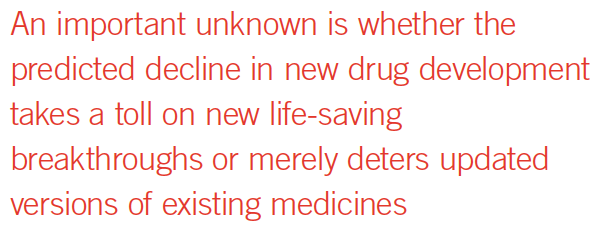Debate Heats Up Over Reference Pricing Plan
Pharmaceutical Executive
Measure would cut drug costs, slash revenues, curb R&D.
The debate over drug pricing legislation accelerated last month as federal budget analysts calculated huge savings for consumers and the nation’s healthcare system from a lead Democratic proposal. The measure would authorize the government to negotiate prices paid by Medicare on up to 250 high-cost medicines and
Jill Wechsler

insulin with the aim of lowering US rates to prices in six leading industrial nations. The analysts acknowledged that this requirement would greatly reduce revenue for pharma companies, a development that industry warned would “blow up” the current system. Progressive Democrats, however, complained that the plan was insufficient and called for even broader price negotiations. The long-term impact of the reference pricing plan is unclear, as patients could benefit from increased access to medicines, but society might be harmed by R&D reductions.
The debate focuses on a key provision in legislation (H.R.3) proposed by House speaker Nancy Pelosi (D-CA) that would require manufacturers to negotiate prices on 25 to 35 medicines a year, eliminating the long-established “noninterference clause” governing Medicare Part D drug plans. The aim is to ensure that US rates are less than 120% of the average international market price (AIM) based on drug costs in Australia, Canada, France, Germany, Japan, and the UK. According to analysis by the non-partisan Congressional Budget Office (CBO), this reference pricing strategy would reduce Medicare spending by $345 billion from 2023 to 2029 and also affect prices in the commercial market.1
On the plus side, lower drug prices would improve the health of Americans by boosting drug utilization and access to medicines. Added savings would come from reduced out-of-pocket spending for drugs and lower health insurance premiums.
However, CBO acknowledges that the program would cut industry revenues by $500 billion to $1 trillion over the same period, precipitating significant changes in the drug market. Companies would lower spending for R&D, which CBO calculates would lead to eight to 15 fewer new therapies coming to market over the next 10 years. And some analysts predict that the R&D decline would be even more noticeable in the future as pharma companies cancel high-risk research efforts.
At the same time, the analysts anticipate that pharma marketers will adjust with new pricing and sales strategies. While CBO expects few companies would pull drugs off the US market entirely, firms might boost launch prices in the US and in the reference countries to maintain revenues. Manufacturers also could offset higher prices overseas, CBO explains, by providing “other forms of compensation that effectively reduce the net price of drugs in other countries.”
Pharma companies that fail to negotiate lower prices or meet other requirements would be subject to a steep excise tax of up to 95% of sales. But the experts don’t expect to collect much revenue from this provision, anticipating that most firms would comply through a range of pricing strategies. At the same time, the tax provision is considered important in driving industry to meet the price reduction provisions, and was key to CBO’s high scoring of potential savings.
Most Republicans agree with industry that federal price negotiations threaten the development of needed cures. Stephen Ubl, president of the Pharmaceutical Research and Manufacturers of America (PhRMA), set the tone, charging that this radical plan would give the federal government “unprecedented, sweeping authority to set medicine prices” and upend the successful Medicare Part D program.
A more moderate legislative proposal from the Senate Finance Committee, which gained some GOP support, offers modest savings by limiting Medicare drug price increases to the rate of inflation. Bipartisan

support is stronger for measures to cap out-of-pocket spending on drugs for Medicare beneficiaries, revise the Part D “donut hole,” and block anticompetitive practices that delay the development of generics and biosimilars.
An important unknown is whether the predicted decline in new drug development takes a toll on new life-saving breakthroughs or merely deters updated versions of existing medicines. Consumer savings on drugs and health insurance could shift spending to other areas that benefit the economy. CBO emphasizes that its analysis is preliminary and doesn’t cover other aspects of the House proposal, but its report clearly reshaped the debate. Despite enthusiasm for the legislation in the Democratic-controlled House, it’s slated to stall in the Senate where a more modest compromise drug pricing measure may move forward by year-end.
Tweaking Medicaid best price
Meanwhile, Congress did approve a small drug pricing provision in legislation approved in September to continue funding the federal government through Nov. 21. The bill passed quickly to avoid a government shutdown when Congress failed to enact necessary spending measures for fiscal year 2020 by Oct. 1. The largely unnoticed drug provision would save the government about $3 billion by closing a loophole that allowed authorized generic drug prices to be used when calculating a brand’s Medicaid rebates, a process that reduces Medicaid rebates for the product.
Analysts who want to link drug prices more to value have been pressing for more complex and significant changes to the Medicaid best price rule, which requires manufacturers to pay rebates of 23% to Medicaid plans and even more to meet any lower price offered to another payer. The policy thus discourages value-based pricing arrangements that reduce the payer’s costs if a drug fails to deliver expected benefits for any patient. Under a recent proposal from the Duke-Margolis Center for Health Policy, such value-based pricing arrangements could be bundled with other drug rates to reduce the impact of lower prices on total reimbursement. Although this and other strategies to update Medicaid best price policy appear reasonable and beneficial to analysts, and may be implemented administratively, such technical changes have failed to gain traction among policymakers.
Jill Wechsler is Pharmaceutical Executive’s Washington Correspondent. She can be reached at jillwechsler7@gmail.com
Reference

Navigating Distrust: Pharma in the Age of Social Media
February 18th 2025Ian Baer, Founder and CEO of Sooth, discusses how the growing distrust in social media will impact industry marketing strategies and the relationships between pharmaceutical companies and the patients they aim to serve. He also explains dark social, how to combat misinformation, closing the trust gap, and more.
FDA Grants Priority Review to Regeneron’s Eylea for Macular Edema Following Retinal Vein Occlusion
April 18th 2025Regulatory action was based on data from the Phase III QUASAR trial, which demonstrated that Eylea HD dosed every eight weeks achieved non-inferior visual acuity outcomes compared to Eylea in patients with macular edema following retinal vein occlusion.